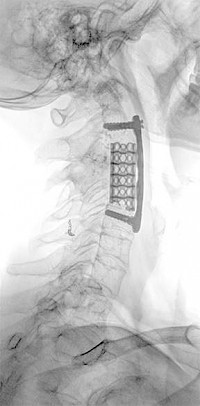Vertebral fractures in the cervical spine
What are the symptoms of a cervical spine fracture?
Fractures of the cervical spine account to merely 15% of all vertebral fractures. Unfortunately, they often go hand in hand with a spinal cord injury. Since vertebral fractures are frequently associated with a rupture of the stabilizing ligaments of the cervical spine, they must be stabilized surgically in most cases.
How cervical spine fracture diagnosed?
In addition to a thorough physical examination, during which abrupt procedures in the cervical spine are of course avoided, the basis for the diagnosis of cervical spine injury is always computed by tomography of the cervical spine. This allows for an exact description of the form and extent of the fracture. If the spine specialist suspects one of the bands on the back of the cervical spine could be injured, an MRI is needed to represent this band injury. A rupture of the cervical intervertebral disc can also only be detected in an MRI.
Which cervical spine fractures can be healed with conservative treatment?
Most vertebral fractures that originate by compression of the vertebra can be treated conservatively. However, these types of fractures are rather rare in the cervical spine. Conservative treatment involves wearing a fixed neck brace for six to eight weeks. Pain is controlled by suitably effective drugs.
Which cervical spine fractures need surgery?
A strong sudden forwards and backwards spin of the head leads to cervical spine injury, distraction or a rotational shearing motion. These type of fractures need to be surgically stabilized, since usually the bones and ligaments of the posterior spinal segment are injured in addition the vertebral bodies. This in turn causes a displacement of the bone with a possible injury to the spinal cord. The same applies to compression fractures that have completely shattered the vertebral body.
All spinal injuries that have caused neurological deficits because of an injury to the spinal cord or individual nerve roots must be stabilized surgically as soon as possible or within 24 hours after the injury occurred.
 What are the procedures for a surgical stabilization of the cervical spine fracture?
What are the procedures for a surgical stabilization of the cervical spine fracture?
The operation of a cervical fracture is usually done from the front, to avoid manipulation of the spinal cord. The surgeon makes a small transverse skin incision of about 3 to 4 centimeters in length. If there is only one injury of the intervertebral disc, it is sufficient to remove the disc and stabilize the segment by inserting a placeholder (cage) made of plastic and a plate. Bone fragments pressing on the spinal cord, must be removed from the spinal canal after removal of the disc. Then a hollow cylinder of titanium, which is filled with autologous bone or donor bone, is used in place of the fractured vertebra. The placeholder is then secured by a plate that is attached to the adjacent vertebral bodies with two screws.
If several vertebrae are broken, it is advisable to stabilize the cervical spine in a second procedure from the back by a screw-rod system.
The hospital stay after surgery of a cervical fracture is approximately 5 to 7 days. Immobilization of the cervical spine is necessary for a period of six weeks, whereby a soft neck collar is sufficient. Cycling and swimming can be resumed after six weeks; all other sports should be discontinued for at least six months.

